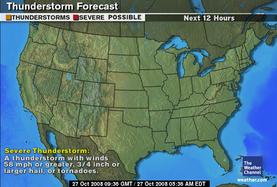Thunderstorms producing tornadoes, large hail, damaging winds, and flooding rains worked overtime during the first five months of 2008. The central and southeastern United States has borne the brunt of the storms' wrath, where at least 11 states have already reached or exceeded their annual average number of tornadoes (VA, NC, SC, GA, AL, MS, LA, AR, TN, KY, MO). MO, KY, and TN have already had more than 150% of the average number of tornadoes for a year.
"Tornado alley" states from TX to NE, IA, SD, and CO began to pick up their tornado pace in late May, and may have also pushed KS and IA above their annual average, though most of these preliminary tornado reports were not confirmed as of this writing.
Record tornado pace
Tornadoes caused 111 deaths through the end of May, the second highest death toll for any year in the Doppler radar era, eclipsed only by the 130 deaths for the year in 1998 (120 of them by May 31).
While tornado counts are still preliminary, it seems almost certain that the number of tornadoes has set a new five-month record, possibly 900 or more, while the previous record for the period was 778 in 1999.
Unusually deadly
The death toll is no doubt high, in part, because of the number of strong and violent, wide and long-track tornadoes. These pack the combination of destructive winds that demolish mobile homes and frame homes alike and a massive area placed at risk by virtue of their size and longevity.
Numerous tornadoes have been rated EF3 or stronger and have had paths exceeding 30 miles. 51% of the deaths have been in mobile homes, 43% in other "permanent" buildings, 14% in vehicles, and 2% outdoors. 96% of the tornado deaths were from tornadoes rated EF2 or stronger; 38 of the deaths from EF4 or EF5 tornadoes.
Early, unusual start
The second-largest tornado outbreak on record for January hit the central US on the January 7 and 8. EF3 tornadoes hit Poplar Grove in northern IL and Wheatland, WI, places where tornadoes are nearly unprecedented in January. There had previously been only one other January tornado in WI and one in northern IL since 1950.
Other EF3 tornadoes hit MO, including a killer near Marshfield. Tornadoes on January 10 hit MS and AL hard, including a school at Caledonia, MS. An EF1 tornado near Vancouver was the first in January on record in Clark County, Washington. I think I would have been taking shelter inside that concrete-walled room in the large building destroyed below in Wheatland, WI.

Building destroyed at Wheatland, WI, 7 January 2008. This and all damage photographs in this blog are courtesy of the National Weather Service, unless otherwise noted.
Not-so-super Tuesday The "Super Tuesday" primary election day was far from super in the lives of thousand of citizens of the Mid-South impacted by the largest February tornado outbreak on record, on February 5-6. At least 79 tornadoes hit 10 states, causing 58 fatalities, in the deadliest tornado outbreak in the United States for any month since May 31, 1985.
Five tornadoes were rated EF4, including one that tracked 123 miles across northern Arkansas that demolished homes and tossed vehicles like toys. It destroyed a boat factory in the photo below. In Tennessee, 517 homes and 61 mobile homes were destroyed and about 300 were destroyed in Arkansas. Union University in Jackson, TN, was hit by one of the EF4 tornadoes, damaging every building. This outbreak helped propel February to a new tornado record for the month, preliminarily, 138.

Boat factory destroyed at Clinton, AR, Feb. 5, 2008.
Southeast pounded
It wasn't just the central U.S. The Southeast was repeatedly hammered, including the greater Atlanta, GA, metro area. An EF3 tornado struck near Carrollton, GA, on February 26, west of Atlanta, while severe thunderstorm winds pummeled other parts of the metro area.
An EF3 tornado hit northwest of Atlanta near Cartersville on March 15, and a tornado outbreak pounded South Carolina. Virginia and North Carolina had tornadoes on several occasions. An EF3 tornado carved a 10-mile, quarter-mile-wide path through Suffolk, VA, on April 28, leaving 150 homes uninhabitable and 1,200 damaged. A killer EF2 tornado cut a path through western Greensboro, NC, on May 9.

Destroyed home in Suffolk, VA, from April 28, 2008, tornado. (AP Photo/Steve Earley)
Direct strike on downtown atlanta
The costliest of the tornadoes to hit the Southeast was the only one of the day. The loner formed just northwest of downtown Atlanta on the evening of March 14 and made a direct hit on the Georgia World Congress Center. An NCAA basketball tournament and an NBA game were being held in adjacent buildings also were impacted -- the Georgia Dome and Phillips Arena.
The tornado put 500 rooms out of service at the Westin Hotel, then headed southeast into a residential area known as Cabbagetown. Total damage was estimated at $150-$200 million. See damage in downtown Atlanta ![]()
It once again shows that no place, including the downtown of a city, is immune to tornado wrath. The aerial photograph below, shows roof and wall damage and windows blown out of one side of the Cotton Mill Lofts building.
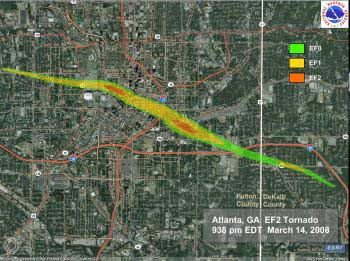
Map of the Atlanta, GA, tornado's path of March 14, 2008. (Courtesy NWS Atlanta)

Roof, wall, and window damage at the Cotton Mill Lofts, Atlanta, March 14, 2008. (Courtesy Atlanta-Fulton County EMA)
Glancing blows to Little Rock and Jackson
While downtown Little Rock, AR, was spared, a family of 10 tornadoes was spawned by a supercell thunderstorm that rolled northeast from south of the city to North Little Rock to Cabot on April 3. Their tracks are shown on the map below. Four were rated EF2, and the one at North Little Rock hit the airport, damaging at least 35 of the 145 aircraft there and sending staff at the National Weather Service to shelter.
The Weather Channel had meteorologist Jeff Morrow covering these storms in the field, and he had to take shelter at his hotel near Cabot when a late-night tornado in the family threatened the area. An EF2 tornado hit the north side of Jackson, Mississippi on April 4.
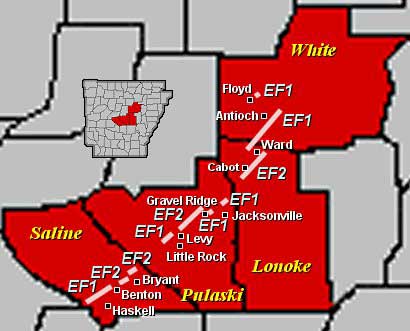
A family of 10 tornadoes spawned from the same thunderstorm passed through the Little Rock area on April 3, 2008. (Courtesy of NWS Little Rock)
May frenzy
May is the month in which the United States averages the most tornadoes (287 is the average over the past 10 years), but it can be erratic. 2007, 2006, and 2005 were "good Mays," all below average, whereas 2004 (509) and 2003 (543) were "bad Mays," the two most tornado-active months on record. 2008 wound up being a "bad May," well above average in preliminary tornado count, although the exact number of tornadoes is not yet known (approximately 497).
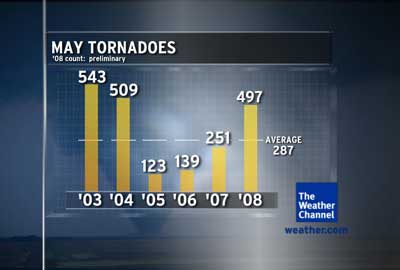
Early May outbreak
A significant outbreak of about 52 tornadoes struck on May 2-3. One EF3 carved a 45-mile path across central AR, an EF2 carved a 40-mile path, and an EF3 damaged or destroyed 350 homes in Earle, AR. Watch a tornado on the ground in AR ![]() Pre-dawn also tornadoes hit the Kansas City metro area.
Pre-dawn also tornadoes hit the Kansas City metro area.

Debris from this demolished home near Damascus, AR, debarked trees, a common sight in strong and violent tornadoes.
Mother's Day weekend
About 85 tornadoes hit the central U.S. and Southeast in a Mother's Day weekend outbreak. Watch a tornado toss cars in AL ![]()
The worst was an EF4 tornado that cut a 75-mile path in northeast OK, including Picher (where 20 blocks were demolished), and into southwest MO, killing 21 people on May 10. Watch the EF4 tornado that destroyed Picher ![]()
Even the bathtub was not a safe place to be in this demolished home at Picher, OK, in the photo below.

Demolished home at Picher, OK, on May 10, 2008.
An EF3 blasted Stuttgart, AR, where 200 homes and 50 businesses had significant damage. The photo below shows heavy damage to a school gym there.

An EF3 tornado blasted this school gym at Stuttgart, AR, on May 10.
On May 11, Mother's Day, destructive and killer tornadoes hit farther south and east, including AL, GA, and SC, some pre-dawn. Included was an EF4 that hit Darien, GA. A photo of a demolished building there is shown below.

Building demolished by the EF4 tornado at Darien, GA, on Mother's Day May 11, 2008.
May 22-25 extended outbreak
Pieces of a near-stagnant upper trough over the West repeatedly moved eastward, spawning numerous tornadoes in the central U.S. starting May 22, before finally moving east with severe weather on the last days of the month. As these upper disturbances interacted with Gulf of Mexico moisture over states in "tornado alley," about one per day, they spawned an extended outbreak of tornadoes from May 22-25.
On May 22, a killer EF3 tornado struck near Windsor, northeast of Denver, CO. See some of the CO tornado damage ![]()
A tornado outbreak hit western KS on May 23, including an EF4 near Quinter, KS. A supercell thunderstorm packing tornadoes and 100 mph rotation weakened briefly as it passed directly over Greensburg, KS, which had been hit by an EF5 tornado from a similar supercell, also on a Friday evening, back on May 4, 2007.
On May 24, a long-lived, slow-moving supercell spawned highly-photographed tornadoes in north-central OK. Then May 25 became the most active day of the year, in terms of having a preliminary total of at least 560 severe weather reports. Topping that list was an EF5 tornado that carved a 43-mile path up to 1.2 miles wide through Parkersburg and New Hartford, IA, killing 7 people. Piles of rubble beside slabs swept clean were a common sight in Parkersburg, as shown below from ground level and the air. See the Parkersburg tornado and damage ![]()

Nothing but piles of rubble left by the EF5 tornado that hit Parkersburg, IA, on May 25, 2008.

Widespread destruction at Parkersburg, IA, May 25, 2008. (AP Photo/Kevin Sanders)
Under water
If it wasn't tornadoes and severe thunderstorms, it was floods, and sometimes in the same areas. On March 18-19, Cape Girardeau, MO, had 13.05 inches of rain, with 9 inches or more reported in southern MO, northern AR, southern IL and southern IN. Over 250 communities in 12 states experienced flood conditions.
Major river flooding continued for at least a week and in some places two weeks. Flooding rains hit some of the same areas on March 31. More rain and runoff brought major flooding to the Mississippi River from April 20 through the end of the month, with the river in Mississippi reaching its highest levels since 1973.

The Black River overflowed its banks and inundated farmland near Newport, AR (March 27).
On July 24, an EF 2 tornado hit New Hampshire. It had a record 50-mile path:
- It was the longest path length of any known tornado in New Hampshire(previous longest was 15 miles in 1955).
- It's the longest path length known in New England (previous longest was 46 miles in New England's strongest tornado, the strong F4 Worcester, Mass., tornado of June 9, 1953).
The map below shows the record path. It caused damage in the towns shown, and also in Northwood, Barnstead, Alton, New Durham, and Effingham. Its path was up to one-third of a mile wide. The tornado lasted about an hour and twenty minutes, from around 11:30 am to about 12:50 pm. The tornado downed thousands of trees, damaged more than 200 homes and structures, and killed one person.
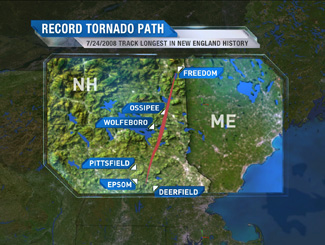
If storm summaries like this interest you, there are many more with tons of details in past blog entries written by Stu Ostro, myself, and others. To keep this blog entry relatively short, many significant tornado and flood events didn't get a mention. You can find information on some of them on our blog.


